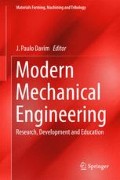Abstract
This chapter reviews the most commonly used techniques used for modeling and optimizing mechanical systems and processes. Statistical and artificial intelligence based tools for modeling are summarized, pointing their advantages and shortcomings. Also, analytic, numeric and stochastic optimization techniques are briefly explained. Finally, two cases of study are developed in order to illustrate the use of these tools, the first one dealing with the modeling of the surface roughness in a drilling process and the other one, on the multi-objective optimization of a hot forging process.
Access this chapter
Tax calculation will be finalised at checkout
Purchases are for personal use only
References
Aalst WMP, Rubin V, Verbeek HMW, Dongen BF, Kindler E, Günther CW (2010) Process mining: a two-step approach to balance between underfitting and overfitting. Softw Syst Model 9:87–111. doi:10.1007/s10270-008-0106-z
Bonabeau E, Dorigo M, Theraulaz G (1999) Swarm intelligence: from natural to artificial systems. Oxford University Press, New York
Foster J, Barkus E, Yavorky C (2006) Understanding and using advanced statistics. SAGE Publishers, London
Friedman N, Geiger D, Goldszmidt M (1997) Bayesian network classifiers. Mach Learn 29:131–163. doi:10.1023/A:1007465528199
Grafarend EW (2006) Linear and nonlinear models: fixed effects, random effects and mixed models. Walter de Gruyter, Berlin
Lewis SG, Raval A, Angus JE (2008) Bayesian Monte Carlo estimation for profile hidden Markov models. Math Comput Model 47:1198–1216. doi:10.1016/j.mcm.2007.07.002
Lyngsø RB, Pedersen CNS (2002) The consensus string problem and the complexity of comparing hidden Markov models. J Comput Syst Sci 65:545–569. doi:10.1016/S0022-0000(02)00009-0
Marler RT, Arora JS (2004) Survey of multi-objective optimization methods for engineering. Struct Multidisc Optim 26:369–395. doi:10.1007/s00158-003-0368-6
Miao Q, Huang HZ, Fan X (2007) A comparison study of support vector machines and hidden Markov models in machinery condition monitoring. J Mech Sci Technol 21:607–615. doi:10.1007/BF03026965
Pernkopf N, Wohlmayr M (2013) Stochastic margin-based structure learning of Bayesian network classifiers. Pattern Recogn 46:4640471. doi:10.1016/j.patcog.2012.08.007
Quiza R, Reis P, Davim JP (2006) Multi-objective optimization of cutting parameters for drilling laminate composite materials by using genetic algorithms. Compos Sci Technol 66:3083–3088. doi:10.1016/j.compscitech.2006.05.003
Rivals I, Personnaz L (2000) Construction of confidence intervals for neural networks based on least squares estimation. Neural Netw 13:463–484. doi:10.1016/S0893-6080(99)00080-5
Sarker R, Mohammadian M, Yao X (2003) Evolutionary optimization. Kluwer Academic Publishers, New York
Schneider JJ, Kirkpatrick S (2006) Stochastic optimization. Springer-Verlag, Berlin
Sha W (2006) Comment on prediction of the flow stress of 0.4C–1.9Cr–1.5Mn–1.0Ni–0.2Mo steel during hot deformation by R.H. Wu et al. [J. Mater. Process. Technol. 116 (2001) 211]. J Mater Process Tech 171:283–284. doi:10.1016/j.jmatprotec.2005.07.004
Utyuzhnikov SV, Fantini P, Guenov MD (2009) A method for generating a well-distributed Pareto set in nonlinear multiobjective optimization. J Comput Appl Math 223:820–841. doi:10.1016/j.cam.2008.03.011
Acknowledgment
The authors acknowledge the kind contribution of MSc. Rui Sendão and MSc. A. Festas in the execution of the experimental work on surface roughness of the titanium alloy drilling process.
Author information
Authors and Affiliations
Corresponding author
Editor information
Editors and Affiliations
Rights and permissions
Copyright information
© 2014 Springer-Verlag Berlin Heidelberg
About this chapter
Cite this chapter
Quiza, R., Beruvides, G., Davim, J.P. (2014). Modeling and Optimization of Mechanical Systems and Processes. In: Davim, J. (eds) Modern Mechanical Engineering. Materials Forming, Machining and Tribology. Springer, Berlin, Heidelberg. https://doi.org/10.1007/978-3-642-45176-8_8
Download citation
DOI: https://doi.org/10.1007/978-3-642-45176-8_8
Published:
Publisher Name: Springer, Berlin, Heidelberg
Print ISBN: 978-3-642-45175-1
Online ISBN: 978-3-642-45176-8
eBook Packages: EngineeringEngineering (R0)

